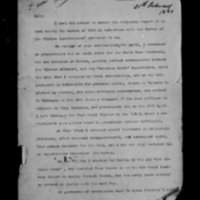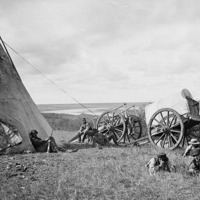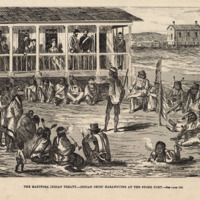Context
Context – Westward Expansion, Surveying, and Conflict from the 1860s to the 1880s
Origins – Land Acquisition and the Dominion Land Survey
In order to get a clear sense of the broader significance of land surveying in Canadian and Manitoba history, one must begin by imagining the ways in which the newly formed federal system viewed the immense mass of land in the Western part of the North American continent which it had yet to settle. The Canadian government, within two years of its confederation, was able to buy Rupert’s Land from its previous owner, the Hudson’s Bay Company.[1]
The impetus behind this 1869 deal, of course, was the government’s aims of populating the West. The government was also aware that the land within this vast territory was highly suitable for farming.[2] The importance of acquiring detailed and extensive knowledge of the qualities of such land – in addition to its anticipation of a flood of Westerly immigration in the wake of their purchase – precipitated the rise of an organized, structured method of land surveying.[3]
The Canadian government seems to have wasted no time in commencing the surveying of the Western lands. In fact, it began drawing up the survey method for the West – and even the surveying process – before it acquired Rupert’s Land.[4] Thus, 1869 saw the “Dominion Lands System” setting in motion the first organized surveys of the West[5] besides the earlier Red River and Assiniboine River surveys.[6] The Order in Council accepted the propositions for how surveys were to be completed on the 23rd of September, 1869.[7] This marked the start of a long, laborious process, which – over fifty years – would survey 178,000,000 acres of land in the Canadian West. However, as will be seen, the earliest Dominion Lands surveys of 1869 were stopped by a series of violent clashes, which were part of broader issues surrounding Canada’s legitimacy as the owner of the land it strove to conquer.
Surveying and Conflict – The 1869 Rebellion
While the Canadian government was committing such actions for increasing its range of land, another group, the Métis, were about to engage in a campaign to challenge such expansion.[8] Surveying of the land was the instrument propelling Canada’s agenda into the West. The plans arranged for surveying by Public Works Minister William McDougall included “preliminary surveys.”[9]
Louis Riel was the driving force behind the Rebellion; Canada’s acquisition of Rupert’s Land in 1869 was the fundamental disputation for Riel and his supporters and the focal point of the Métis stance.[10] The aforementioned early surveying activity has been mentioned – by authors like Chester Bailey Martin – as a “pretext” for the first Riel Rebellion at Red River.[11],[12] Martin also suggests that the larger threat of westward expansion was a major catalyst in the uprising.[13] J. G. MacGregor notes that the activities of J. S. Dennis and Simon J. Dawson, among others, were conducted with a “lack of consultation” with the Métis settlers already living in the area. He claims that surveyors were simply “sparks” that ignited the bad relations between the Métis and the central Canadian government, ultimately resulting in what is known today as the Red River Rebellion.[14]
The rebellions in 1869 caused sufficient strain on government relations with the Métis that surveying under the new system was temporarily suspended.[15] The government survey did not commence again until 1871.[16]
Moving Past the Rebellion – Legislation, Surveying, and Treaties
In 1870, The Manitoba Act signaled an attempt to ameliorate the complaints put forth by the Métis, although its shortcomings have been also been highlighted.[17]With the creation of the province of Manitoba, the Canadian government assumed control of the territory[18], and in anticipation of a high level of immigration to Manitoba, the legislation implemented “safeguards” for the settlers already living there.[19]
Meanwhile, after a short hiatus during the Rebellion, Dominion Lands surveying exploded after its re-commencement over the summer of 1871.[20] The beginning of the year had seen a revision and improvement of the prior surveying method.[21] In Manitoba and the Northwest Territories, the Dominion Lands Act of 1871 set in place such a process.[22] Interestingly, surveyors under this system were paid at a rate of “so much per mile,” although by 1872, complaints arose surrounding the fairness of this scheme.[23] In general terms, however, 1872 represented a year of massive development in surveying the Western lands.[24] In a positive light, the Canadian surveying project has been praised as one in which “uniformity of administration”[25], cost efficiency[26], and even – despite the Riel Rebellions – a result that was relatively conflict-free.[27] The 1871 survey system was a direct attempt at imitating that of the United States, but Canada sought to avoid the complications that had arisen in America due to rapid settlement taking place before an adequate survey of the land. Instead, the Canadian government wanted access to information about the land to be settled before immigration proceeded.[28]
One interesting dimension of surveying in the early 1870s was the extensive reliance on “horses and Red River carts” for purposes of transportation; these tools permitted a method of long-distance travel that impressed many surveyors.[29] In 1874, work started on surveying Indian reservations, especially in Manitoba and the North-West Territories.[30] While the 1870s were generally a period of elaborate progress in the Canadian government’s development of the West, the treatment of Aboriginals and Métis throughout these years were to create popular dissatisfaction, and once again, surveying would become implicated in settler disputes and deeply ingrained hostilities.
Treaties, Modes of Life, and Resistance
In settling the region then known as the North-West Territories, the Canadian government tried – with limited success – not to make the same mistakes it had made in its intrusive, non-communicative early dealings with the Métis.[31] Their strategy ultimately consisted of Treaties Four, Five, Six, and Seven; in these agreements, the government acquired land for settlement, while agreeing to provide the First Nations populations with various forms of compensation. However, it appears as though the Aboriginal population did not have much choice but to accept such terms; they were faced with ravaging disease and a lack of buffalo to hunt. These factors, in turn, prompted many First Nations groups to accept the terms of the treaties.[32] Rolling River First Nation, residing in the Rolling River # 67 Reserve, is known as having been one of the “original” signatories[33] of Treaty Four, which was brought to various groups in the 1870s.[34] However, the exact year of their agreement to the treaty is not known.[35]
As illustrated before, land surveying was an essential component of the Canadian government’s tactics of claiming and negotiating its sovereignty over the Western lands, many of which were already inhabited by Aboriginal and Métis populations. This raises ethical questions concerning the practice of surveying in general; was it simply the instrument of a forceful government used in order to conquer lands through means less confrontational than outright warfare?
The Métis opposition to Canadian surveying is a potential response to such a question. Many Métis, facing an extinct buffalo population in Manitoba, started to occupy land in the North-West Territories. There, they continued their prior organization of the land, that of “long, narrow lots…along river banks”. This contrasted with the Canadian federal aim of subdividing its newly acquired land “on the rectangular plan,” and caused a number of disputes which contributed to the Northwest Rebellion of 1885.[36] While this division between conceptions of the land spoiled federal-Métis relations in the 1880s, the blame should by no means be placed solely by Métis. Thomas Flanagan remarks that both sides made mistakes during this period which ultimately precipitated a second Métis resistance movement.[37]
[1] Thomas Flanagan, Riel and the Rebellion: 1885 Reconsidered (Saskatoon: Western Producer Prairie Books, 1983), 15.
[2] Canada, Sessional Papers: Second Session of the Seventh Parliament of the Dominion of Canada (volume nine). J. S. Dennis. (A Short History of the Surveys Performed under the Dominion lands System, 1869 to 1889; print), 1892, 1 [part six].
[3] Dennis, 1890, 1.
[4] Chester Bailey Martin, “Dominon Lands” Policy (Toronto: McClelland and Stewart, 1973), 16.
[5] J. G. MacGregor, Vision of an Ordered Land: The Story of the Dominion Land Survey (Saskatoon: Western Producer Prairie Books, 1981), ix.
[6] Dennis, 1890, 1.
[7] Martin, 16.
[8] Paul L.A.H. Chartrand, Manitoba’s Métis Settlement Scheme of 1870 (Saskatoon: University of Saskatchewan Native Law Centre, 1991), 3.
[9] Martin, 8.
[10] Flanagan, 3.
[11] Martin, 8.
[12] MacGregor, 1-2.
[13] Martin, 20.
[14] MacGregor, 2.
[15] Dennis, 1890, 2.
[16] MacGregor, 8.
[17] Flanagan, 3.
[18] Jennifer Reid, Louis Riel and the Creation of Modern Canada: Mythic Discourse and the Postcolonial State (Winnipeg: University of Manitoba Press, 2012), 11.
[19] Chartrand, 3.
[20] MacGregor, 8.
[21] Dennis, 1890, 6.
[22] Dennis, 1890, 8.
[23] Dennis, 1890, 7.
[24] Dennis, 1890, 7.
[25] Flanagan, 15.
[26] Flanagan, 22.
[27] Flanagan, 22.
[28] Flanagan, 16.
[29] MacGregor, 15-16.
[30] Dennis, 1890, 9.
[31] Reid, 14.
[32] Reid, 14-15.
[33] John Leonard Taylor, Treaty Research Report: Treaty Four (1874) (Ottawa: Treaties and Historical Research Centre – Indian and Northern Affairs Canada, 1985), 53.
[34] Taylor, i.
[35] Taylor, 53.
[36] Flanagan, 14.
[37] Flanagan, 15.


